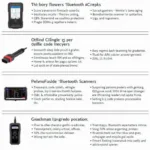Dealing with a pesky check engine light in your Hyundai Accent? Understanding hyundai accent obd2 codes is the first step to diagnosing and fixing the issue. These codes are your car’s way of telling you something’s not right. This guide will help you decipher those mysterious codes and get your Accent back on the road.
Whether it’s a minor hiccup or a more serious problem, knowing how to interpret these codes can save you time and money. Let’s dive into the world of Hyundai Accent OBD2 codes and empower you to take control of your car’s health. Check out our resources on obd2 codes hyundai accent for more specific information.
Decoding the Secrets of Your Hyundai Accent’s OBD2 System
The OBD2, or On-Board Diagnostics II, system is a standardized system found in most vehicles manufactured after 1996, including your Hyundai Accent. It acts as your car’s internal communication network, constantly monitoring various systems and components. When something goes wrong, the OBD2 system generates a specific diagnostic trouble code (DTC), commonly referred to as an OBD2 code.
These codes are formatted using a standardized alphanumeric structure, such as P0420 (Catalyst System Efficiency Below Threshold). The letter indicates the system affected (e.g., P for Powertrain), and the following numbers specify the particular problem. Understanding this structure is key to interpreting what your Hyundai Accent is trying to tell you. For example, problems with the evaporative emission system might show up as obd2 evap not ready, requiring further diagnosis.
Common Hyundai Accent OBD2 Codes and Their Meanings
While numerous OBD2 codes can appear in a Hyundai Accent, some are more common than others. Let’s explore a few examples:
-
P0420: This code often indicates a problem with the catalytic converter. It could mean the converter itself is failing or that there’s an issue with the oxygen sensors.
-
P0171: This code suggests the engine is running lean, meaning there’s too much air and not enough fuel in the air/fuel mixture. This could be due to a vacuum leak, a faulty mass airflow sensor, or a problem with the fuel injectors.
-
P0300: This is a random misfire code, indicating that one or more cylinders are not firing correctly. Spark plugs, ignition coils, or fuel injectors could be the culprits. Specifically for the P0442 code on a Hyundai Accent, visit obd2 code p0442 hyundai accent for detailed information.
-
P0442: This code often signals a small leak in the Evaporative Emission Control (EVAP) system. This system prevents fuel vapors from escaping into the atmosphere.
How to Retrieve Hyundai Accent OBD2 Codes
Retrieving the codes from your Hyundai Accent is a straightforward process. You’ll need an OBD2 scanner, a readily available and affordable device. Simply plug the scanner into the OBD2 port (usually located under the dashboard on the driver’s side), turn on the ignition, and follow the scanner’s instructions. The scanner will display the stored codes, allowing you to pinpoint the problem. If you’re looking for where to find the OBD2 plug in a 2014 Accent, see 2014 accent obd2 plug.
What to Do After Retrieving Hyundai Accent OBD2 Codes
Once you have the codes, it’s essential to research their specific meaning for a Hyundai Accent. While general definitions exist, some nuances might apply to specific makes and models. obd2 repair manuals can be invaluable resources for this. Consulting repair manuals specific to your Hyundai Accent’s year and model will provide more accurate information and potential solutions.
Don’t jump to conclusions based solely on the codes. They provide a starting point for diagnosis, not a definitive answer. Further inspection and testing are often necessary to determine the root cause of the problem. Consider consulting a qualified mechanic for a comprehensive diagnosis and repair.
Expert Insights on Hyundai Accent OBD2 Codes
“Understanding your car’s OBD2 system is like having a direct line of communication with its inner workings,” says automotive expert, John Miller, ASE Certified Master Technician. “It’s a powerful tool that can empower you to take proactive steps in maintaining your vehicle’s health.”
“Don’t ignore those check engine lights,” adds Sarah Johnson, Lead Diagnostic Technician. “Addressing issues early can prevent more significant and costly repairs down the road.”
Conclusion: Taking Charge of Your Hyundai Accent’s Health
Hyundai Accent OBD2 codes are valuable clues that can help you identify and address potential problems. By understanding how to retrieve and interpret these codes, you can take a proactive approach to maintaining your car’s performance and longevity. Don’t let those hyundai accent obd2 codes intimidate you; they are your allies in keeping your Accent running smoothly.
FAQ
-
Where is the OBD2 port located in my Hyundai Accent? It’s usually under the dashboard on the driver’s side.
-
Can I fix the problem indicated by the OBD2 code myself? While some issues are simple fixes, others require professional expertise.
-
What if the check engine light comes back on after clearing the codes? This suggests the underlying problem hasn’t been resolved.
-
Do all Hyundai Accents have an OBD2 system? Models manufactured after 1996 should have an OBD2 system.
-
How often should I check my Hyundai Accent’s OBD2 codes? It’s a good practice to check them periodically, especially if you notice any performance issues.
-
Can I use any OBD2 scanner with my Hyundai Accent? Most standard OBD2 scanners will work.
-
What if my OBD2 scanner isn’t reading any codes? Check the connection and ensure the ignition is on.
Need further assistance? Contact us via WhatsApp: +1(641)206-8880, Email: [email protected] or visit us at 789 Elm Street, San Francisco, CA 94102, USA. Our 24/7 customer service team is always ready to help.

